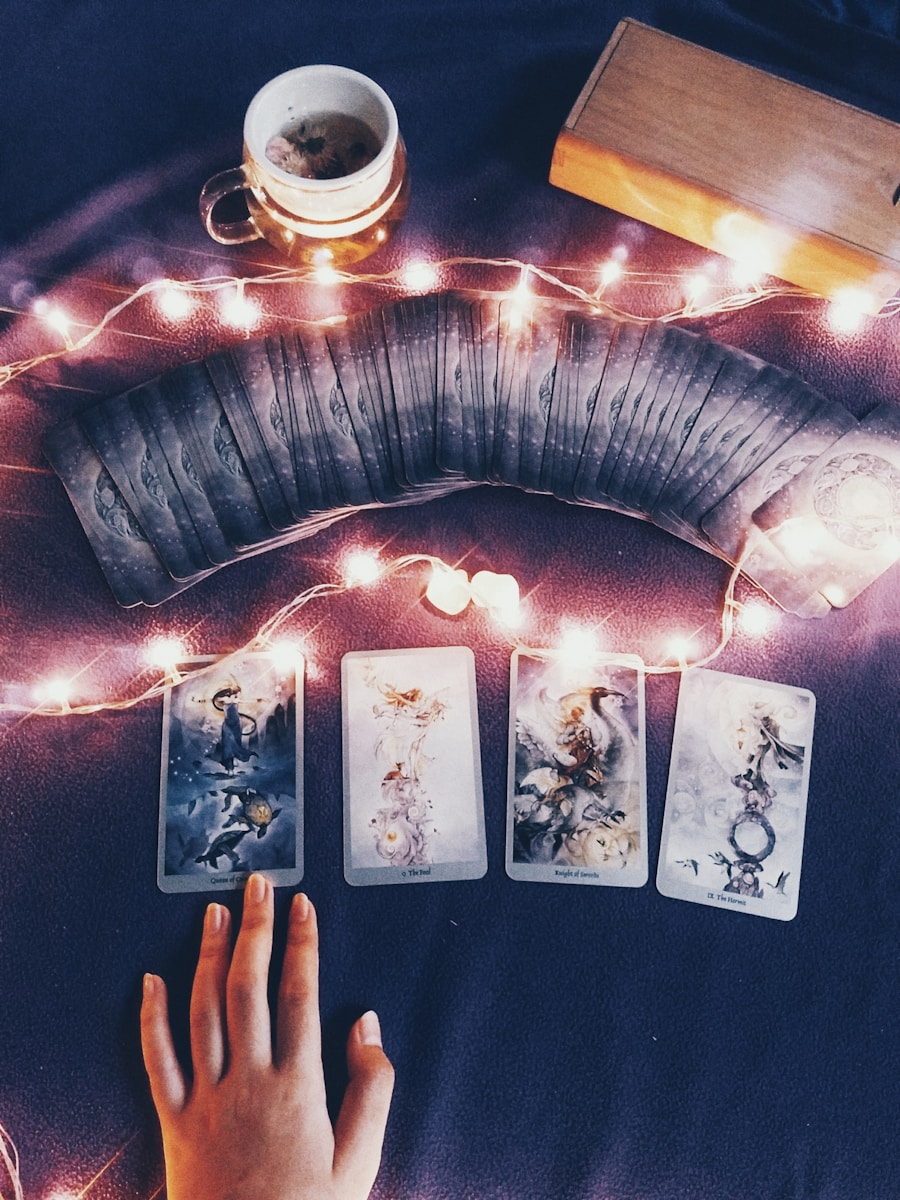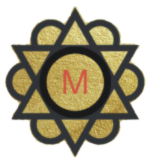
Tarot cards have long been shrouded in mystery and intrigue, often associated with divination and fortune-telling. However, their origins trace back to the 15th century in Europe, where they were initially used as playing cards. The tarot deck typically consists of 78 cards, divided into two main sections: the Major Arcana and the Minor Arcana.
The Major Arcana comprises 22 cards that represent significant life themes and spiritual lessons, while the Minor Arcana consists of 56 cards that delve into everyday experiences and challenges. Each card is rich with symbolism, imagery, and meaning, making them powerful tools for introspection and self-discovery. Understanding the structure of tarot cards is essential for anyone looking to incorporate them into their meditation practice.
Each card is imbued with archetypal energies that can resonate with different aspects of the human experience. For instance, The Fool represents new beginnings and spontaneity, while The Tower signifies upheaval and transformation. By familiarizing oneself with these symbols, practitioners can tap into the deeper meanings behind each card, allowing for a more profound meditation experience.
The imagery on the cards can evoke emotions and thoughts that may not surface in everyday life, providing a unique lens through which to explore one’s inner landscape.
Key Takeaways
- Tarot cards are a tool for self-reflection and insight, often used in meditation and mindfulness practices.
- Setting a clear intention before a tarot card meditation can help guide the focus and purpose of the practice.
- Choosing the right tarot card for meditation involves selecting a card that resonates with the intention and desired energy.
- Tarot cards can be used to focus and ground meditation by visually and symbolically representing the intended energy or message.
- Reflecting and journaling with tarot cards after meditation can help deepen the understanding and insight gained from the practice.
- Incorporating tarot cards into daily mindfulness practices can help cultivate a deeper connection with oneself and the present moment.
Setting the Intention for Meditation with Tarot Cards
Setting a clear intention is a crucial step in any meditation practice, and when combined with tarot cards, it can enhance the depth of the experience. An intention serves as a guiding principle, helping to focus the mind and heart during meditation. When using tarot cards, one might begin by selecting a card that resonates with their current emotional state or life situation.
This card can serve as a focal point for meditation, allowing the practitioner to explore its meaning in relation to their own life. For example, if someone is grappling with feelings of uncertainty about their career path, they might choose The Chariot card, which symbolizes determination and willpower. By meditating on this card, they can reflect on their own drive and ambition, contemplating how they can harness these qualities to navigate their professional journey.
This process not only clarifies their intention but also creates a deeper connection between the individual and the card’s symbolism. As they meditate, they may find insights emerging that guide them toward actionable steps or shifts in perspective.
Choosing the Right Tarot Card for Meditation

Selecting the right tarot card for meditation is a deeply personal process that can vary from one individual to another. Some practitioners prefer to draw a card at random from their deck, allowing fate to guide their choice. This spontaneous approach can lead to unexpected revelations and insights, as the chosen card may address issues that the individual has not consciously acknowledged.
Others may opt for a more intentional selection process, choosing a card that aligns with specific themes or questions they wish to explore during meditation. When choosing a card, it is essential to consider what resonates on an emotional or intuitive level. For instance, someone seeking clarity in their relationships might be drawn to The Lovers card, which embodies themes of connection and choice.
Alternatively, an individual looking to cultivate inner strength may find themselves attracted to The Strength card, symbolizing courage and resilience. The key is to trust one’s intuition during this selection process; often, the card that evokes a strong emotional response is the one that holds the most significance for the individual’s current journey.
Using Tarot Cards to Focus and Ground Your Meditation
Once a tarot card has been selected for meditation, it can serve as an anchor for focus and grounding throughout the practice. The imagery and symbolism of the card can be used as a visual aid to help quiet the mind and center one’s thoughts. Practitioners may begin by finding a comfortable seated position and placing the chosen card in front of them or holding it in their hands.
This physical connection to the card can enhance its presence in the meditation space. As they settle into their meditation, individuals can take a few deep breaths while gazing at the card’s imagery. This process allows them to absorb its symbolism fully, inviting it into their consciousness.
For example, if meditating on The Star card, which represents hope and inspiration, one might visualize themselves surrounded by a starry sky, feeling a sense of peace and possibility wash over them. This visualization can deepen their connection to the card’s energy, fostering a sense of calm and clarity as they navigate their thoughts and emotions during meditation.
Reflecting and Journaling with Tarot Cards
After completing a meditation session with tarot cards, taking time for reflection and journaling can significantly enhance the insights gained during the practice. Journaling allows individuals to articulate their thoughts and feelings about the experience while also providing a tangible record of their journey. This process can involve writing down any revelations or emotions that surfaced during meditation, as well as how these insights relate to their current life circumstances.
For instance, if someone meditated on The Hermit card, which signifies introspection and solitude, they might reflect on their need for quiet time away from external distractions. In their journal, they could explore questions such as: What insights did I gain about my inner self?
This reflective practice not only solidifies the lessons learned but also encourages ongoing self-exploration and growth. Over time, individuals may notice patterns or recurring themes in their journaling that can inform future meditative practices.
Incorporating Tarot Cards into Daily Mindfulness Practices

Starting the Day with Intention
For example, individuals might draw a card each morning as part of their daily routine, using it as a prompt for reflection or intention-setting for the day ahead. This practice encourages individuals to consider how the card’s themes may manifest in their daily experiences.
Finding Guidance in Times of Need
Additionally, tarot cards can be used as tools for grounding during moments of stress or anxiety. When faced with overwhelming emotions or challenging situations, individuals can turn to their tarot deck for guidance. By selecting a card that resonates with their current feelings or circumstances, they can gain perspective and clarity on how to navigate those challenges. For instance, drawing The Empress card may remind someone of the importance of nurturing themselves during difficult times, prompting them to engage in self-care practices that promote emotional well-being.
Cultivating Purpose and Clarity
Incorporating tarot cards into daily mindfulness practices fosters a deeper connection between individuals and their inner selves while also enhancing their ability to navigate life’s complexities with grace and awareness. By embracing this multifaceted approach to tarot, practitioners can cultivate a more profound sense of purpose and clarity in their lives.
If you are interested in exploring the mystical world of tarot cards further, you may want to check out The Tower Tarot Card: Embracing Change and Transformation. This article delves into the symbolism and meaning behind the Tower card, offering insights into how it can help guide you through periods of upheaval and transformation. It is a fascinating read that complements the practice of using tarot cards for meditation and mindfulness.
FAQs
What are tarot cards?
Tarot cards are a deck of 78 cards that are often used for divination, meditation, and self-reflection. Each card has its own imagery and symbolism, and can be interpreted in various ways.
How can tarot cards be used for meditation?
Tarot cards can be used for meditation by focusing on the imagery and symbolism of a specific card. This can help to quiet the mind, gain insight, and promote mindfulness.
What is mindfulness?
Mindfulness is the practice of being fully present and engaged in the current moment, without judgment. It involves paying attention to thoughts, feelings, and sensations without getting caught up in them.
How can tarot cards be used for mindfulness?
Tarot cards can be used for mindfulness by using them as a tool for self-reflection and introspection. By focusing on the imagery and symbolism of the cards, individuals can gain insight into their thoughts and emotions, and cultivate a greater sense of self-awareness.
Are there specific tarot card spreads for meditation and mindfulness?
There are various tarot card spreads that can be used for meditation and mindfulness, such as the “Mind-Body-Spirit” spread or the “Self-Reflection” spread. These spreads are designed to help individuals gain insight and clarity in specific areas of their lives.
Is it necessary to have experience with tarot cards to use them for meditation and mindfulness?
No, it is not necessary to have experience with tarot cards to use them for meditation and mindfulness. Anyone can use tarot cards as a tool for self-reflection and introspection, regardless of their level of experience with the cards.






